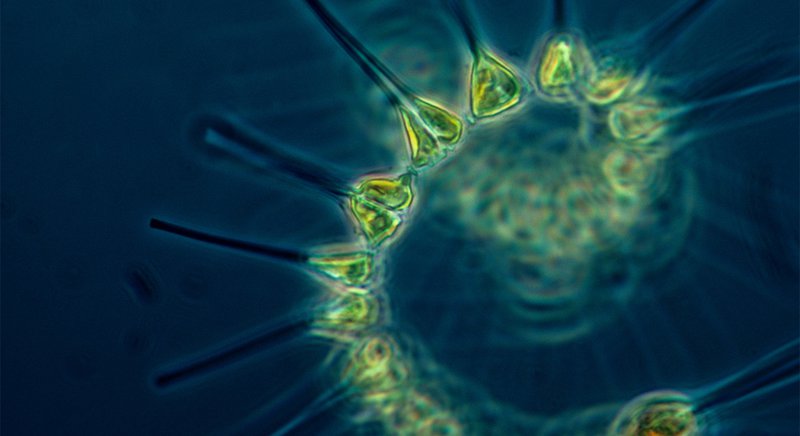Biosecurity
Farmers should be vigilant to avoid introducing pests and pathogens (microorganisms such as parasites, bacteria, and viruses that cause disease) to their own farm and other farmed and wild resources. Pests and pathogens can lower product quality, kill animals, and have negative environmental consequences.

Questions
Biosecurity
-
In aquaculture, biosecurity means taking measures to reduce:
- The risk of introducing pests and pathogens that are not already present at a farm.
- The impacts of pests and pathogens that are present.
- The transmission of pests and pathogens from one farm to other farms or wild resources.
-
A plan for minimizing the risk of introducing pests and pathogens to your farm as well as managing ones already present to reduce the negative effects on your crops and surrounding resources. An effective biosecurity plan requires understanding what pests and pathogens are of greatest risk, and the likely pathways of introduction (i.e. seed), so you can take measures to minimize negative impacts and avoid spreading them (i.e. purchase seed from approved hatcheries or that has been tested for pests and pathogens).
-
Pests and pathogens can directly impact profit by reducing product quality and increasing mortalities, creating an unpredictable product, and increasing production costs. A low-quality product will bring a low price (if it can be sold at all). Higher mortality rates mean fewer pounds/number of product to sell.
Aquaculturists operate in an open system with shared water between farm sites and wild resources. The actions of one have the potential to affect many. For example, one person bringing infected shellfish into a river or bay can set off a disease outbreak that results in mortalities and long-term economic losses for others in that region. As a responsible business owner and community member, it's important to prevent the introduction of any pests or pathogens to new areas.
-
It depends. Some are quite ubiquitous while others are river or bay specific.
-
Simple, don’t move product or gear from your farm to another area without first checking with the Maine Department of Marine Resources Aquaculture Division scientific staff. It is against the law to import (bring to Maine from another state) or, in certain circumstances, transfer live marine organisms between water bodies in Maine without a permit from The Maine Department of Marine Resources. Gear should always be properly cleaned and disinfected prior to installation.
-
To test for microscopic pests that cannot be seen with the naked eye, contact Maine Department of Marine Resources Aquaculture Division scientific staff and/or a professional diagnostic testing lab such as Kennebec River Biosciences. Otherwise, be observant. Look for and write down which biofouling organisms are present and when, allowing you to manage your farm to minimize negative impacts.
-
You will need to determine the best course of treatment specific to the pest you are dealing with. Common treatments for common oyster pests are air exposure, salt brines, freshwater dips, and temporary storage in an industrial refrigerator.
Professional diagnostic labs can provide specific recommendations for managing pathogens that are already present at your site. To help prevent any issues, purchase disease-resistant seed from hatcheries approved by Maine DMR, if applicable.
-
Contact a professional marine diagnostic laboratory, such as Kennebec River Biosciences, who can help determine if you have an infection. They will advise you on what kinds of data to collect and help determine what next steps you should take to collect a proper sample. If you do get confirmation of disease, you should notify Maine DMR. By notifying Maine DMR they can help mitigate the potential spread and conduct additional screening in the region.
Oysters
-
In Maine, oyster parasites/pathogens could include: Dermo (Perkinsus marinus), MSX (Haplosporidium nelsoni), SSO (Haplosporidium costale), Vibrio parahemolyticus, and ROD (Roseovarius crassostreae), previously known as JOD (Juvenile Oyster Disease). Maine is relatively naïve to oyster parasites and disease compared to other New England and southern states. Our goal is to make sure it stays that way! To help prevent any issues, purchase disease-resistant seed from hatcheries approved by Maine DMR, if applicable.
-
In Maine, oyster pests may include an array of biofouling organisms such as macroalgae, sponges, bryozoans, hydrozoans, tunicates, ascidians (sea squirts, sea vase), barnacles, mud blister worms (Polydora websteri), and other polychaete worms.
Mussels
-
In Maine, mussel parasites/pathogens could include: Dermo (Perkinsus marinus), neoplasia, and trematodes.
-
In Maine, mussel pests may include an array of biofouling organisms such as macroalgae, bryozoans, hydrozoans, tunicates, ascidians (sea squirts, sea vase), barnacles, mud blister worms (Polydora websteri), and other polychaete worms.
Kelp
-
There are none for concern in Maine.
-
Algal and diatom epiphytes and endophytes, which normally have the most negative effect on the tips of the kelp blades.
The marine snail Lacuna vincta, a very small snail that eats the kelp blades and can leave behind eggs that are very hard to remove. Lacuna vincta can range in color from bright yellow to dark brown and can range in size from as small as a grain of sand to as large as a dime. Their eggs are a light cream color and are shaped like a doughnut.
The bryozoan Membranipora spp. which grows in lacey, scaly patches on the surface of kelp blades and is very difficult to remove.
Biosecurity Resources
-
Visit Shellfish Biosecurity: Risks, Management & Best Practices Bivalve Shellfish Physiology, Pathogens, Diseases
-
Visit Biosecurity on the Farm - Guidelines & Resources for Developing a Biosecurity Plan
-
Visit Dead and Dying Shellfish: What to Do?
-
-
-
